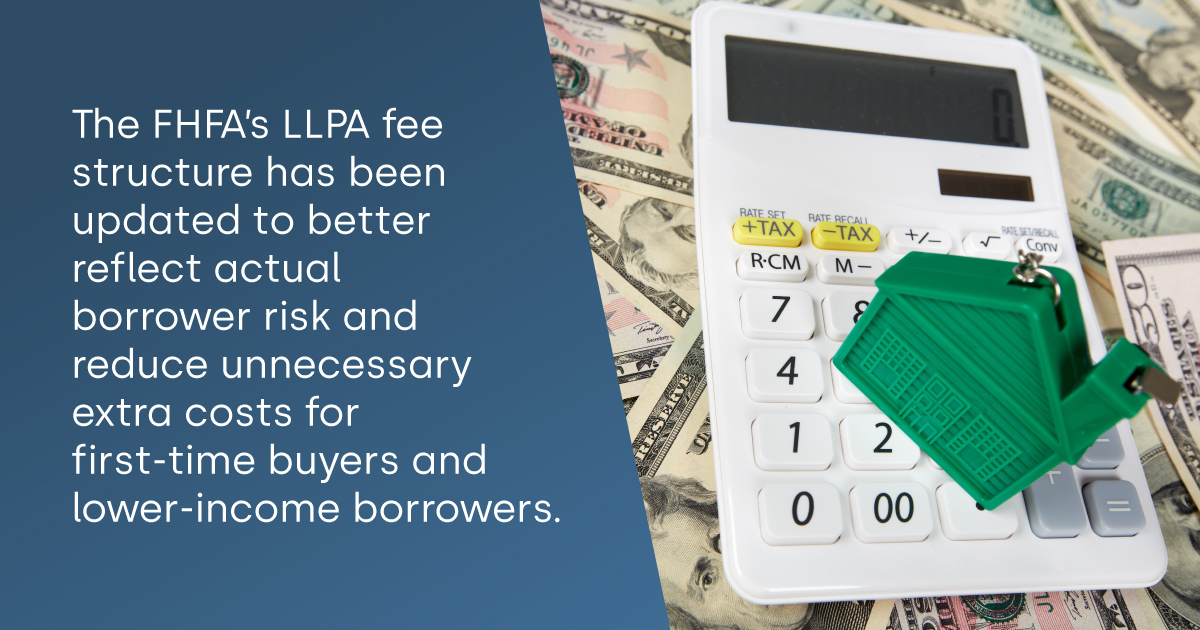
Recent changes in mortgage fees for conventional loans have many potential homebuyers worried that their mortgage rates could climb even higher. While increases may be experienced by some buyers, this does not hold true for every individual. In fact, many buyers will notice no changes at all, while others, especially first-time homebuyers who can’t afford large down payments, may actually see their rates decrease.
In this post, we’d like to clear up some of the misconceptions surrounding the fee increases for conventional home loans and provide clear information for how changes could affect your mortgage rate.
What Is The New Mortgage Fee Rule?
Many individuals with conventional mortgages aren’t aware that part of their interest rate includes a small fee that aligns with the credit risk of each borrower. Each individual borrower has their own level of risk based on a number of factors like their:
- Loan-to-value ratio, or LTV: How much they are able to put down on their home to offset the loan amount.
- Debt-to-income ratio, or DTI: How much money they have to pay each month for their total debts compared to their income.
- Credit score.
The higher the LTV and DTI, and the lower the credit score, the more likely they will default on their mortgage and lenders will lose money on the loan.
The Federal Housing Finance Agency (FHFA) has incorporated annual and upfront fees into their Freddie Mac and Fannie Mae mortgages since 2008 after the mortgage crisis, but their fee system hadn’t been recalibrated to reflect actual borrower risk in a long time. It particularly harmed lower-income individuals who had higher debt-to-income ratios—the higher fees they had to pay did not accurately reflect the actual risk they presented to banks or the FHFA, and became an additional barrier to home ownership. That’s why the FHFA raised the qualifying DTI ratio several years ago, eliminated extra upfront fees for first-time buyers last year, and scrapped plans for an additional fee for individuals with debt-to-income ratios above 40%.
Beginning May 1, 2023, the FHFA’s loan-level price adjustments (LLPAs) fee structure has also been updated to better reflect actual borrower risk and reduce unnecessary extra costs for first-time borrowers and lower-income borrowers. For some types of borrowers, fees went up modestly. For some, the fees remained the same. For other borrowers, fees went down.

How Do The New Mortgage Fees Work?
Keep in mind that prior to this change, people still paid fees as part of their mortgage interest rate. The fees have just changed for some individuals. The new fee system is designed to reflect many different financial factors, there isn’t a single across-the-board change. In fact, the new framework now includes 81 different ways to classify borrowers for each mortgages and refinances, each with their own specific fee rate. For conventional home loans, fees range from 0% for borrowers with credit scores over 780 who put down at least 25% (LTV of 75% or over) to 2.875% for borrowers with credit scores below 639 who put down 15-19.9% on their home (LTV of 80.01 – 85.00%).
Generally, the higher your credit score and the more you put down on your home, the lower your fee will be. There is one exception to this rule: Homeowners who have low credit but aren’t able to put down at least 15% on their home may end up paying a lower fee than those who have low credit but can put down more than 15%. This exception is meant to help low-income and first-time buyers who may not have a large down payment. However, individuals with good credit will always pay a lower fee than those with worse credit who have the same percentage down payment.
On top of standard LLPA fees, there are additional fees for certain types of loans, like adjustable rate mortgages (ARMs), and loans for investment properties, manufactured homes, and loans for condos.
Let’s look at a few scenarios:
- Borrower #1 is purchasing a second home with 30% down (70% LTV). She has a credit score of 740. While her LLPA is 0%, however, because the mortgage is for a second home, an additional LLPA fee of 1.25% will be incorporated into her mortgage rate. In previous years, this additional LLPA would have been higher at 1.625%.
- Borrower #2 is purchasing a home with a 20% down payment (80% LTV). He has a credit score of 680. His LLPA will be 1.5%. In previous years, he would have been the same.
- Our third borrowers are a couple purchasing a home with a 15% down payment. Their credit scores are both in the 740-759 range. Their LLPA will be 1%. In previous years, their LLPA would have been .25% lower.
What Types of Mortgages are Affected by the New Change?
The FHFA only regulates Fannie Mae and Freddie Mac mortgages (new loans or refinances). These loans are also commonly called “conventional loans”. Fannie Mae and Freddie Mac mortgages account for about 70% of home loans in the US.
However, many Alachua and Marion County first-time homebuyers choose alternative mortgage products that are government backed and require lower down payments, including FHA Loans, VA Loans, Rural Development (RD) Section 502 Mortgages, and HUD Section 184 Mortgages. These loan products are excluded from the new FHFA mortgage fees. In fact, FHA loans, one of the most popular options for first-time home buyers and buyers without large down payments, has just gotten more affordable. As Biden recently announced, FHA borrowers will see their annual mortgage insurance premium fees decreased from .85% to .55%.
To learn more about different types of home loans and places that offer mortgage financing, visit our Local Financing and Loan Options Guide.

What Is The Reason For These Mortgage Fee Changes?
As we discussed above, adjustments to mortgage fees are designed to remove unnecessary barriers of home ownership to borrowers with lower down payments and lower credit scores and make home ownership more attainable. In the face of higher interest rates which make it harder to purchase a first home, lowering these fees (and thus the interest rate) can be the difference between getting approved for a loan and getting denied because of a debt-to-income ratio that is too high.
Furthermore, as director of the FHFA Sandra L. Thompson explains, the FHFA Enterprises have relied on a “taxpayer backstop” since 2008. Rate increases “will better protect taxpayers in the long term and put the Enterprises on more durable footing, which will allow them to support affordable, sustainable mortgage credit across the economic cycle to the benefit of all Americans.”
The changes have been criticized because in some cases, individuals with higher credit scores may see their LLPA go up. For these borrowers, the increase is often not significant, and, as the chief economist of Redfin, Daryl Fairweather pointed out, may go entirely unnoticed in a time of turbulent mortgage rates.
Our Agents Can Help You Navigate Mortgage Changes
Are you looking to buy a house in Central Florida? We know there are many fees and expenses associated with homeownership, and the prospect of additional costs can feel discouraging. Rest-assured, for most homebuyers, changes will be negligible or even beneficial—helping put homeownership in reach for many.
Our experienced Ocala and Gainesville Real Estate Agents can help you find the right home for your needs and budget in Marion or Alachua County, assist new homebuyers navigate the process of buying your first home, and understand mortgage options available to you to find the most cost-effective home loan. Reach out to us today to see what we can do for you!
